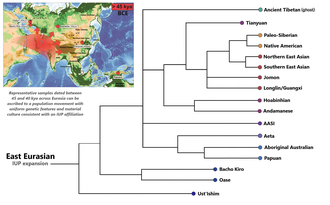Ancient Northern East Asians




In archaeogenetics, the term Ancient Northern East Asian (ANEA), also known as Northern East Asian (NEA), is used to summarize the related ancestral components that represent the Ancient Northern East Asian peoples, extending from the Baikal region to the Yellow River and the Qinling-Huaihe Line in present-day central China.[1][3] They are inferred to have diverged from Ancient Southern East Asians (ASEA) around 20,000 to 26,000 BCe.[1][4][5][6]
The ANEA can be differentiated into broadly three sub-groups, namely the “Ancient Northeast Asians“ (ANA), “Neo-Siberians", and "Yellow River farmers". The ANEA are to be distinguished from the namely similar "Ancient Northeast Asian" (ANA) lineage, which is alternatively also known as "Amur ancestry", and which forms a sub-group of the ANEA grouping, specifically ancestral to hunter-gatherer people of the 7th-4th millennia before present, in far-eastern Siberia, Mongolia and the Baikal regions, but which are most closely related to other ancient northern East Asians.[2][7]
To the north, the Ancient Northern East Asian lineage is inferred to have contributed to the formation of the Ancient Paleo-Siberians (APS) in conjunction with the Ancient North Eurasians (ANE), and, in the south, to the formation of the "Yellow River farmers" in conjunction with the Ancient Southern East Asians (ASEA).[1][4] Yellow River farmers are associated with the spread of Sino-Tibetan languages.[8]
Neolithic populations
The ANEA lineage is represented by Early Neolithic samples including Devil's Gate (Far East Russia, ~7.7 kya), Shandong (coastal China, ~9.5-7.5 kya) and Lake Baikal (southern Siberia, ~7.1-6.3 kya) individuals.[1]
References
- ^ a b c d e Zhang, Ming; Fu, Qiaomei (2020-06-01). "Human evolutionary history in Eastern Eurasia using insights from ancient DNA". Current Opinion in Genetics & Development. Genetics of Human Origin. 62: 78–84. doi:10.1016/j.gde.2020.06.009. ISSN 0959-437X. PMID 32688244. S2CID 220671047.
- ^ a b Yang, Melinda A. (2022-01-06). "A genetic history of migration, diversification, and admixture in Asia". Human Population Genetics and Genomics. 2 (1): 1–32. doi:10.47248/hpgg2202010001. ISSN 2770-5005.
Using f4-statistics, both DevilsCave_N and AR14K share a close genetic relationship to each other and group phylogenetically with other ancient northern East Asian individuals rather than ancient southern East Asian individuals [61,68].
- ^ Yang, Melinda A.; Fan, Xuechun; Sun, Bo; Chen, Chungyu; Lang, Jianfeng; Ko, Ying-Chin; Tsang, Cheng-hwa; Chiu, Hunglin; Wang, Tianyi; Bao, Qingchuan; Wu, Xiaohong; Hajdinjak, Mateja; Ko, Albert Min-Shan; Ding, Manyu; Cao, Peng (2020-07-17). "Ancient DNA indicates human population shifts and admixture in northern and southern China". Science. 369 (6501): 282–288. Bibcode:2020Sci...369..282Y. doi:10.1126/science.aba0909. ISSN 0036-8075. PMID 32409524. S2CID 218649510.
- ^ a b Yang, Melinda A.; Fan, Xuechun; Sun, Bo; Chen, Chungyu; Lang, Jianfeng; Ko, Ying-Chin; Tsang, Cheng-Hwa; Chiu, Hunglin; Wang, Tianyi; Bao, Qingchuan; Wu, Xiaohong; Hajdinjak, Mateja; Ko, Albert Min-Shan; Ding, Manyu; Cao, Peng (2020-07-17). "Ancient DNA indicates human population shifts and admixture in northern and southern China". Science. 369 (6501): 282–288. Bibcode:2020Sci...369..282Y. doi:10.1126/science.aba0909. ISSN 1095-9203. PMID 32409524. S2CID 218649510.
- ^ Gakuhari, Takashi; Nakagome, Shigeki; Rasmussen, Simon; Allentoft, Morten E.; Sato, Takehiro; Korneliussen, Thorfinn; Chuinneagáin, Blánaid Ní; Matsumae, Hiromi; Koganebuchi, Kae; Schmidt, Ryan; Mizushima, Souichiro; Kondo, Osamu; Shigehara, Nobuo; Yoneda, Minoru; Kimura, Ryosuke (2020-08-25). "Ancient Jomon genome sequence analysis sheds light on migration patterns of early East Asian populations". Communications Biology. 3 (1): 437. doi:10.1038/s42003-020-01162-2. ISSN 2399-3642. PMC 7447786. PMID 32843717.
- ^ Mao, Xiaowei; Zhang, Hucai; Qiao, Shiyu; Liu, Yichen; Chang, Fengqin; Xie, Ping; Zhang, Ming; Wang, Tianyi; Li, Mian; Cao, Peng; Yang, Ruowei; Liu, Feng; Dai, Qingyan; Feng, Xiaotian; Ping, Wanjing (2021-06-10). "The deep population history of northern East Asia from the Late Pleistocene to the Holocene". Cell. 184 (12): 3256–3266.e13. doi:10.1016/j.cell.2021.04.040. ISSN 0092-8674. PMID 34048699. S2CID 235226413.
- ^ Sikora, Martin; Pitulko, Vladimir V.; Sousa, Vitor C.; Allentoft, Morten E.; Vinner, Lasse; Rasmussen, Simon; Margaryan, Ashot; de Barros Damgaard, Peter; de la Fuente, Constanza; Renaud, Gabriel; Yang, Melinda A.; Fu, Qiaomei; Dupanloup, Isabelle; Giampoudakis, Konstantinos; Nogués-Bravo, David (June 2019). "The population history of northeastern Siberia since the Pleistocene". Nature. 570 (7760): 182–188. Bibcode:2019Natur.570..182S. doi:10.1038/s41586-019-1279-z. hdl:1887/3198847. ISSN 1476-4687. PMID 31168093. S2CID 174809069.
- ^ Liu, Li; Chen, Jian; Wang, Jiajing; Zhao, Yanan; Chen, Xingcan (2022-12-20). "Archaeological evidence for initial migration of Neolithic Proto Sino-Tibetan speakers from Yellow River valley to Tibetan Plateau". Proceedings of the National Academy of Sciences. 119 (51): e2212006119. Bibcode:2022PNAS..11912006L. doi:10.1073/pnas.2212006119. ISSN 0027-8424. PMC 9907151. PMID 36508670.